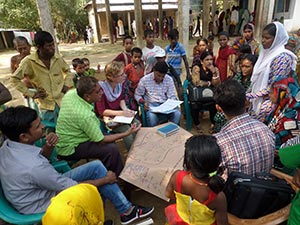Max Foundation strives to eradicate stunting by introducing an innovative, integrated multi-sector approach in their pilot project Growing UpUpUp. To measure the impact of the interventions, Max Foundation invited the Royal Tropical Institute (KIT) to test the effect of integrated approaches on stunting reduction with evidence found in project Growing UpUpUp.
KIT developed a tailor-made health impact evaluation, consisting of a base- and end-line study and a mid term evaluation. In order to provide the evidence base for the effectiveness of the Max Foundation approach of their Growing UpUpUp project, the main research objectives are 1) collecting data that can proof a reduction on prevalence of stunting in the project, and 2) provide evidence that this decrease, when seen, is the result of the interventions of Max Foundation integrated approach.
Stunting prevalence – Sample Survey
At the start of the project in 2017, KIT researcher visited Bangladesh, travelling to the project area, that covers all 73 villages in the Noarai and Islampur union of Chhatak in the north-eastern Sylhet. They trained and provided guidance to the VERC staff to collect data for the baseline study, consisting of a quantitative sample survey of 786 female respondents with at least one young child, and qualitative focus group discussions.
Measuring stunting, i.e. being too short for their age, is relatively easy with the help of the Z-score, an international applied standard deviation score. If a child scores below -2 SD, it is considered stunted, indicating chronic malnutrition. In the sample survey KIT excludes the measurements of children from 0-5 months (N=26) for practical reasons to reduce mistakes, because small babies are difficult to measure accurately. Furthermore, stunting becomes more visible, after a period of 6 months of exclusive breastfeeding, when children require additional nutritious food. KIT notes a high level of stunting in the project area as overall 49% of the children aged 6-24 months (N=360) are stunted. This is 10% higher rate compared to the 2014 DHS survey in Sylhet division, measuring 39% prevalence of stunting for the same age group. The prevalence of stunting is higher among older children; overall 64 % of the children aged 25-59 months (N=400) are stunted. However the prevalence remains more or less stable after the age of two.
Significant Risk Factors
The KIT baseline study creates an immense database on social-economic conditions in the project area, on water, sanitation and hygiene, on health, nutrition, safe motherhoods and SHRH. It holds lots of valuable information. Key to thorough analyses is to detect correlations among variables, showing significant associations with stunting, thus indicating a strong impact. Among a list of variables associated with stunting among children 6-23 months old in the baseline study sofar, KIT identified three factors, i.e. age of child, exclusive breastfeeding till 6 month, and the literacy rate of mothers.
The age of the child relates to stunting, as data suggest that the odds of stunting increases with age until two years. Children within the age of 12-18 months and 18-24 months have respectively 2.71 and 7.39 higher odds on being stunted than children aged 5-12 months. As most respondents have almost no knowledge on stunting, raising awareness through regular monitoring of the height of young children can serve as an early warning system and encourage parents and community to take prompt action.
Exclusive breastfeeding data analyses suggest a positive impact. Children who are living in a household were the last born child has received exclusive breastfeeding for 6 months are less prone to become stunted than children living in households were exclusive breastfeeding was not practiced. With an average 71% of the mothers in the survey giving exclusive breastfeeding to their babies for six months, this leaves space for improvement. More so in Islampur union with 70% exclusive breastfeeding compared to 82% in Noarai union.
The literacy rate of mothers also shows an association to stunting, with children whose mothers completed secondary education are less prone to stunting as compared to children whose mothers are of illiterate. According to the sample survey one third of the respondents are illiterate, while only 10% completed secondary education. While various studies show that education of mothers has a positive impact on the wellbeing of the family, the question remains whether this is exclusively linked to education, or also pointing to other factors such as the socio-economic condition of the household as a whole or family income. Poorer families might limit the education of their children as they need an extra hand in the household or can’t afford the additional cost of schooling, while educated parents are more willing to send their children to school, knowing the benefits of literacy and knowledge.
Impact multi-sectoral approach
The baseline study on its own doesn’t yet provide the necessary data to measure the impact of the project interventions. KIT researchers need at least the midterm monitoring data to see if they can detect indicators that the project is moving in the right direction. However, the baseline study shows that Max Foundation is working on the right location. The Growing UpUpUp pilot project can make its presence worthwhile, contributing in fight against stunting by providing valuable strategy inputs based on scientific based evidence.











 (11)
(11)